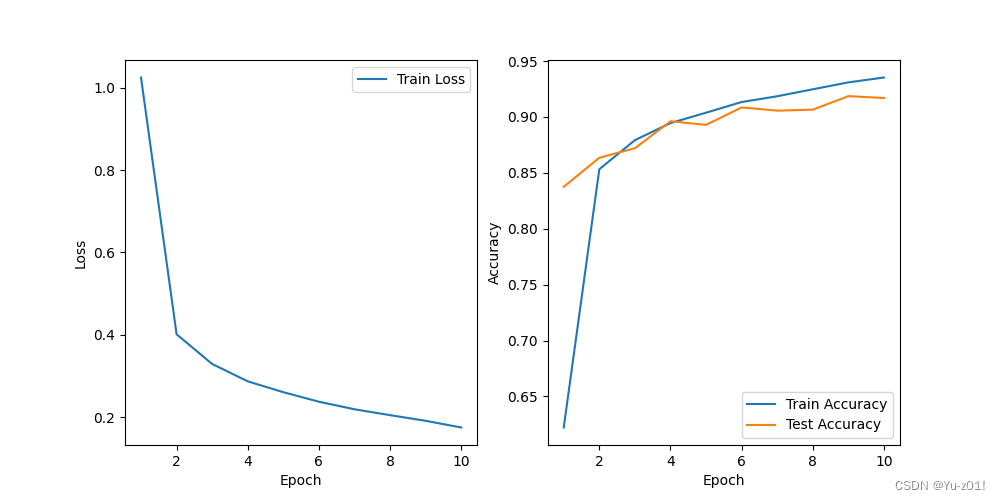本文是笔者在学习深度学习过程中的代码分享,主要是对实现代码的一些注释
dl库中的函数
#计时器
class Timer:
"""记录多次运行时间"""
def __init__(self):
self.times = []
self.start()
def start(self):
"""启动计时器"""
self.tik = time.time()
def stop(self):
"""停止计时器并将时间记录在列表中"""
self.times.append(time.time() - self.tik)
return self.times[-1]
def avg(self):
"""返回平均时间"""
return sum(self.times) / len(self.times)
def sum(self):
"""返回时间总和"""
return sum(self.times)
def cumsum(self):
"""返回累计时间"""
return np.array(self.times).cumsum().tolist()
#加载图片分类数据集
def load_data_fashion_mnist(batch_size, resize=None):
"""下载Fashion-MNIST数据集,然后将其加载到内存中"""
trans = [transforms.ToTensor()]
if resize:
trans.insert(0, transforms.Resize(resize))
trans = transforms.Compose(trans)
mnist_train = torchvision.datasets.FashionMNIST(
root="../data", train=True, transform=trans, download=True)
mnist_test = torchvision.datasets.FashionMNIST(
root="../data", train=False, transform=trans, download=True)
return (data.DataLoader(mnist_train, batch_size, shuffle=True,num_workers=2,pin_memory=False),
data.DataLoader(mnist_test, batch_size, shuffle=False,num_workers=2,pin_memory=False))
#使用gpu
def try_gpu(i=0):
"""如果存在,则返回gpu(i),否则返回cpu()"""
if torch.cuda.device_count() >= i + 1:
return torch.device(f'cuda:{i}')
return torch.device('cpu')
#计算精度
def evaluate_accuracy_gpu(net, data_iter, device=None): #@save
"""使用GPU计算模型在数据集上的精度"""
if isinstance(net, nn.Module):
net.eval() # 设置为评估模式
if not device:#设置为网络模型中的第一个参数的设备
device = next(iter(net.parameters())).device#net.parameters() 返回迭代器包含神经网络模型中的所有参数
# 正确预测的数量,总预测的数量
metric = Accumulator(2)#累加两个变量的累加器
with torch.no_grad():
for X, y in data_iter:
#将张量移动到指定设备上
if isinstance(X, list):
X = [x.to(device) for x in X]
else:
X = X.to(device)
y = y.to(device)
metric.add(accuracy(net(X), y), y.numel())
return metric[0] / metric[1]
#训练模型
def train_cnn(net, train_iter, test_iter, num_epochs, lr, device):
"""用GPU训练模型"""
def init_weights(m):#初始化权重参数
if type(m) == nn.Linear or type(m) == nn.Conv2d:
nn.init.xavier_uniform_(m.weight)
net.apply(init_weights)
print('training on', device)
net.to(device)#将网络放到gpu
optimizer = torch.optim.SGD(net.parameters(), lr=lr)#优化算法(梯度下降)
loss = nn.CrossEntropyLoss()#损失函数(交叉熵损失)
timer, num_batches = Timer(), len(train_iter)#计时器
train_losses, train_accuracies, test_accuracies = [], [], []#三个存储列表
for epoch in range(num_epochs):
metric = Accumulator(3) # 累加器:训练损失之和,训练准确率之和,样本数
net.train()#训练模式
for i, (X, y) in enumerate(train_iter):
timer.start()#启动计时器
optimizer.zero_grad()#清空梯度
X, y = X.to(device), y.to(device)#将数据放到gpu
y_hat = net(X)#计算输出
l = loss(y_hat, y)#计算损失
l.backward()#计算梯度
optimizer.step()#更新参数
with torch.no_grad():
metric.add(l * X.shape[0], accuracy(y_hat, y), X.shape[0])
timer.stop()#停止计时器
train_l = metric[0] / metric[2]#平均损失
train_acc = metric[1] / metric[2]#平均准确率
#存储损失和准确率同来绘图
train_losses.append(train_l)
train_accuracies.append(train_acc)
#测试数据集准确率
test_acc = evaluate_accuracy_gpu(net, test_iter)
test_accuracies.append(test_acc)
# 绘制训练过程中的损失和准确率
epochs = range(1, num_epochs + 1)
plt.figure(figsize=(10, 5))
plt.subplot(1, 2, 1)
plt.plot(epochs, train_losses, label='Train Loss')
plt.xlabel('Epoch')
plt.ylabel('Loss')
plt.legend()
plt.subplot(1, 2, 2)
plt.plot(epochs, train_accuracies, label='Train Accuracy')
plt.plot(epochs, test_accuracies, label='Test Accuracy')
plt.xlabel('Epoch')
plt.ylabel('Accuracy')
plt.legend()
plt.show()
print(f'loss {train_l:.3f}, train acc {train_acc:.3f}, '
f'test acc {test_acc:.3f}')
print(f'{metric[2] * num_epochs / timer.sum():.1f} examples/sec '
f'on {str(device)}')调用pytorch实现VGG
import torch
from torch import nn
from dl import torch as dl
#定义vgg块
def vgg_block(num_convs, in_channels, out_channels):
layers = []#创建一个存储层的列表
#根据参数添加卷积层
for _ in range(num_convs):
layers.append(nn.Conv2d(in_channels, out_channels,kernel_size=3, padding=1))#卷积层
layers.append(nn.ReLU())#RuLu激活函数
in_channels = out_channels#之后每个卷积层的输入输出通道相同
layers.append(nn.MaxPool2d(kernel_size=2,stride=2))#加最大池化层
return nn.Sequential(*layers)#将层列表放入容器当中
#构建VGG-11
def vgg(conv_arch):
conv_blks = []#创建一个存储vgg块的列表
in_channels = 1#初始输入通道
# 卷积层部分
for (num_convs, out_channels) in conv_arch:#取出每个块的参数
conv_blks.append(vgg_block(num_convs, in_channels, out_channels))#构建vgg块
in_channels = out_channels#更新进入下一个块的输入通道
#将vgg块列表放入Sequential中,在展平后添加全连接层
return nn.Sequential(
*conv_blks, #vgg块叠加
nn.Flatten(),#展平层
# 全连接层部分
nn.Linear(out_channels * 7 * 7, 4096), nn.ReLU(), nn.Dropout(0.5),#RuLu激活函数,概率为0.5的丢弃法
nn.Linear(4096, 4096), nn.ReLU(), nn.Dropout(0.5),#RuLu激活函数,概率为0.5的丢弃法
nn.Linear(4096, 10))#输出层
#构建模型
conv_arch = ((1, 64), (1, 128), (2, 256), (2, 512), (2, 512))#5个块的参数(卷积层数,输出通道数)
ratio = 4
small_conv_arch = [(pair[0], pair[1] // ratio) for pair in conv_arch]#构建通道数较小的网络
net = vgg(small_conv_arch)
#加载数据
batch_size =128
train_iter, test_iter = dl.load_data_fashion_mnist(batch_size, resize=224)
#训练模型
lr, num_epochs= 0.05, 10
if __name__ == "__main__":
dl.train_cnn(net, train_iter, test_iter, num_epochs, lr, dl.try_gpu())运行结果显示






















 731
731











 被折叠的 条评论
为什么被折叠?
被折叠的 条评论
为什么被折叠?








